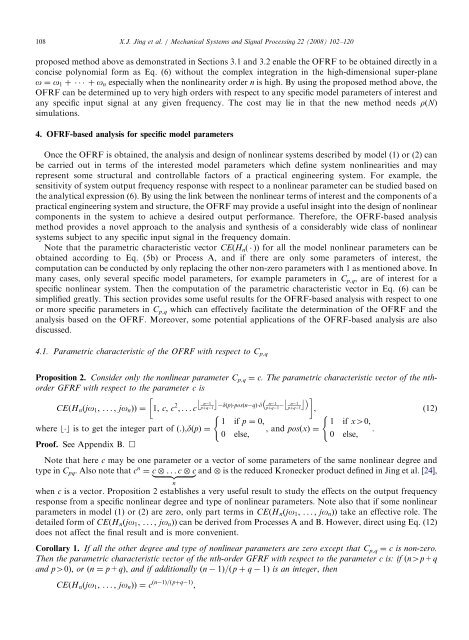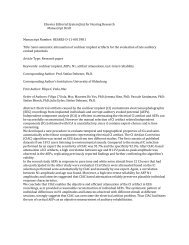Output frequency response function-based analysis for nonlinear ...
Output frequency response function-based analysis for nonlinear ...
Output frequency response function-based analysis for nonlinear ...
Create successful ePaper yourself
Turn your PDF publications into a flip-book with our unique Google optimized e-Paper software.
108<br />
proposed method above as demonstrated in Sections 3.1 and 3.2 enable the OFRF to be obtained directly in a<br />
concise polynomial <strong>for</strong>m as Eq. (6) without the complex integration in the high-dimensional super-plane<br />
o ¼ o1 þ þon especially when the <strong>nonlinear</strong>ity order n is high. By using the proposed method above, the<br />
OFRF can be determined up to very high orders with respect to any specific model parameters of interest and<br />
any specific input signal at any given <strong>frequency</strong>. The cost may lie in that the new method needs r(N)<br />
simulations.<br />
4. OFRF-<strong>based</strong> <strong>analysis</strong> <strong>for</strong> specific model parameters<br />
Once the OFRF is obtained, the <strong>analysis</strong> and design of <strong>nonlinear</strong> systems described by model (1) or (2) can<br />
be carried out in terms of the interested model parameters which define system <strong>nonlinear</strong>ities and may<br />
represent some structural and controllable factors of a practical engineering system. For example, the<br />
sensitivity of system output <strong>frequency</strong> <strong>response</strong> with respect to a <strong>nonlinear</strong> parameter can be studied <strong>based</strong> on<br />
the analytical expression (6). By using the link between the <strong>nonlinear</strong> terms of interest and the components of a<br />
practical engineering system and structure, the OFRF may provide a useful insight into the design of <strong>nonlinear</strong><br />
components in the system to achieve a desired output per<strong>for</strong>mance. There<strong>for</strong>e, the OFRF-<strong>based</strong> <strong>analysis</strong><br />
method provides a novel approach to the <strong>analysis</strong> and synthesis of a considerably wide class of <strong>nonlinear</strong><br />
systems subject to any specific input signal in the <strong>frequency</strong> domain.<br />
Note that the parametric characteristic vector CE(Hn( )) <strong>for</strong> all the model <strong>nonlinear</strong> parameters can be<br />
obtained according to Eq. (5b) or Process A, and if there are only some parameters of interest, the<br />
computation can be conducted by only replacing the other non-zero parameters with 1 as mentioned above. In<br />
many cases, only several specific model parameters, <strong>for</strong> example parameters in Cp,q, are of interest <strong>for</strong> a<br />
specific <strong>nonlinear</strong> system. Then the computation of the parametric characteristic vector in Eq. (6) can be<br />
simplified greatly. This section provides some useful results <strong>for</strong> the OFRF-<strong>based</strong> <strong>analysis</strong> with respect to one<br />
or more specific parameters in C p,q which can effectively facilitate the determination of the OFRF and the<br />
<strong>analysis</strong> <strong>based</strong> on the OFRF. Moreover, some potential applications of the OFRF-<strong>based</strong> <strong>analysis</strong> are also<br />
discussed.<br />
4.1. Parametric characteristic of the OFRF with respect to C p,q<br />
Proposition 2. Consider only the <strong>nonlinear</strong> parameter Cp,q ¼ c. The parametric characteristic vector of the nthorder<br />
GFRF with respect to the parameter c is<br />
n 1<br />
n 1<br />
pþq 1 dðpÞ posðn qÞ d pþq 1<br />
n 1<br />
pþq 1 , (12)<br />
CEðHnðjo1; ...; jonÞÞ ¼ 1; c; c 2 ; ...c<br />
(<br />
1<br />
where bcis to get the integer part of (.),dðpÞ ¼<br />
0<br />
Proof. See Appendix B. &<br />
(<br />
if p ¼ 0;<br />
1<br />
, and posðxÞ ¼<br />
else;<br />
0<br />
if x40;<br />
.<br />
else;<br />
Note that here c may be one parameter or a vector of some parameters of the same <strong>nonlinear</strong> degree and<br />
type in Cpq. Also note that cn ¼ c ...c c and is the reduced Kronecker product defined in Jing et al. [24],<br />
|fflfflfflfflfflfflfflffl{zfflfflfflfflfflfflfflffl}<br />
n<br />
when c is a vector. Proposition 2 establishes a very useful result to study the effects on the output <strong>frequency</strong><br />
<strong>response</strong> from a specific <strong>nonlinear</strong> degree and type of <strong>nonlinear</strong> parameters. Note also that if some <strong>nonlinear</strong><br />
parameters in model (1) or (2) are zero, only part terms in CEðHnðjo1; ...; jonÞÞ take an effective role. The<br />
detailed <strong>for</strong>m of CEðHnðjo1; ...; jonÞÞ can be derived from Processes A and B. However, direct using Eq. (12)<br />
does not affect the final result and is more convenient.<br />
Corollary 1. If all the other degree and type of <strong>nonlinear</strong> parameters are zero except that Cp,q ¼ c is non-zero.<br />
Then the parametric characteristic vector of the nth-order GFRF with respect to the parameter c is: if (n4p+q<br />
and p40), or (n ¼ p+q), and if additionally ðn1Þ= ðpþq1Þ is an integer, then<br />
CEðHnðjo1; ...; jonÞÞ ¼ c<br />
ðn1Þ= pþq 1 ð Þ ,<br />
ARTICLE IN PRESS<br />
X.J. Jing et al. / Mechanical Systems and Signal Processing 22 (2008) 102–120

















